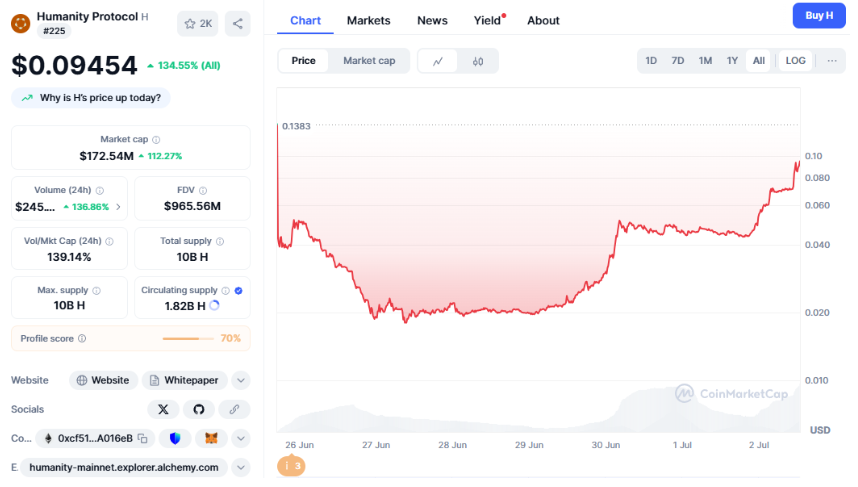When the K-line chart of $H once again drew that terrifying green column, soaring 95.2% in 24 hours, the entire cryptocurrency market seemed to hear two intertwined voices: one was the ecstatic shouting after stepping on the express train of wealth, and the other was the alarm bell of the huge controversy over this project. The story of Humanity Protocol, which is dubbed as a "demon coin" by the market, is far more complicated than a simple myth of getting rich quickly. It was listed on first-tier exchanges such as Bitget in the spotlight, setting a single-day increase of 125%; it also plummeted by more than 61% due to a catastrophic crisis of trust at the beginning of its birth.

This kind of wild fluctuation is not just market speculation. It is the real-time change of odds in a grand gamble. The stakes are: in an era where artificial intelligence (AI) is increasingly blurring the boundaries between humans and machines, how can we prove that "I am a human being"?
The story of H is an epic about a "flawed savior" trying to answer this ultimate question. It has two diametrically opposed but coexisting narrative threads: one is the "bright thread" led by top venture capital firms PanteraCapital and JumpCrypto, which are valued at $1.1 billion; the other is the "dark thread" in which the founder personally admits that the network has been "occupied" by robots and the airdrop has become a disaster. It is the rift between these two forces that has created H's "demon nature".
Vision: To create a “human layer” in the fog of AI
The story of $H begins with an increasingly urgent era of anxiety. When nearly half of the Internet traffic comes from robots and when deepfake technology is enough to be indistinguishable from the real thing, the foundation of trust in the digital world is collapsing. "Sybil attacks" - where a single entity manipulates the network by creating a large number of false identities - are eroding every corner of the Web3 world like a plague.
The Humanity Protocol was created to address this crisis. Its vision is so grand and exciting: to build a global foundational "trust layer" or "human layer" with the goal of "bringing the first billion humans into Web3."
In order to achieve this seemingly impossible task, it designed a set of sophisticated technical solutions:
- A more moderate "proof of humanity": At its core is "proof of humanity" (PoH). But unlike its competitor Worldcoin's controversial iris scanner (Orb), $H chose palm print recognition, which is less invasive and more acceptable to the public. In the first stage, users only need to use their smartphone camera to complete the verification, greatly reducing the threshold for participation.
- Privacy-first zero-knowledge proof: To dispel people’s fear of biometric information leakage, the protocol uses zero-knowledge proof (ZKPs) technology. The user’s palm print information is converted into a string of encrypted mathematical gibberish on the local device, completing the “humanity” verification without leaking any original data.
- Solid underlying architecture: It builds a Layer 2 network compatible with Ethereum based on Polygon CDK, ensuring its future scalability and developer-friendliness.
This perfect "dragon-slaying story" attracted the top capital to enter the market and also laid the groundwork for its subsequent surge.
Original Sin: A Protocol Against "Witches", Captured by "Witches"
However, at the most glorious moment when the dragon slayer was about to show his sword, he was bitten by the evil dragon he swore to destroy. This constitutes the "original sin" that cannot be erased in the $H story.
During its token airdrop event called “Fairdrop”, disaster struck. A protocol whose core mission is to resist Sybil attacks was, ironically, overwhelmed by a massive army of bots during its initial token distribution.
The trigger of the crisis was the confession of founder Terrance Kwok in a community dialogue. He admitted that among the 9 million "human IDs" that the project had previously hyped, "a considerable number are actually robots", and the number of real effective human users is "approaching one million".
This means that up to 88% of early user data may be false. This is a fatal blow to the trust of a "Proof of Humanity" project. As soon as the news came out, the community's trust collapsed instantly, and the token price plummeted. An airdrop that should have been the fairest turned into a carnival for "scientists" (referring to professionals who use scripts to make profits) and a disaster for real users.
This failure profoundly reveals the fatal mistake of the project: before its most powerful weapon, palm print scanning verification, was deployed and enforced on a large scale, the door of the vault was hastily opened to a group of early accounts with weak protection. This is tantamount to distributing treasures in advance before the castle is built.
The mirror battle with Worldcoin and the philosophical debate with Vitalik Buterin
$H is not fighting alone. From the day it was born, it has been in a battle for sovereignty over the future of "digital identity". To understand its positioning, it must be placed in the context of its main competitor Worldcoin and the profound thinking framework of Ethereum founder Vitalik Buterin.

$H's strategic intention is extremely clear: it exists almost as a "mirror" of Worldcoin, trying to systematically solve every pain point exposed by the latter. Worldcoin's Orb hardware is centralized and disturbing, $H focuses on lightweight mobile phone scanning; Worldcoin's iris data collection has triggered a global regulatory storm, $H chooses "less invasive" palm prints. It is like a keen "fast follower", taking advantage of the trial and error of the forerunners to provide the market with a seemingly better option.
However, despite the tactical confrontation between the two, from a larger philosophical perspective, they may both fall into the "single trap" warned by Vitalik Buterin. Vitalik has repeatedly warned that any single identity system, no matter how sophisticated the design, once it becomes dominant, may erode the precious "pseudonymity" of the Internet and eventually become a tool for surveillance. He advocates a diversified identity system. From this perspective, it may not be important who wins or loses the war between $H and Worldcoin; what is really worth being vigilant about is whether this war will end with a "complete victory" for one side.
VC, genomics and cross-border ambitions
$H's confidence comes not only from the technical narrative, but also from the strong capital and strategic alliances behind it. The "war fund" of more than 50 million US dollars from top VCs such as Pantera Capital and Jump Crypto is the basis for its courage to make this gamble. The VCs' bet is that in the AI era, reliably verifying "human nature" will become a trillion-dollar rigid market.
If VC’s funds are ammunition, then its series of strategic collaborations constitute its combat forces. Its ambition goes far beyond “proving that you are human.”
The most eye-catching and controversial one is the cooperation with Nasdaq-listed genomics company Prenetics. According to the agreement, Prenetics will use its flagship product CircleDNA to issue "proof of human nature" certificates through DNA testing.
This is the logical end of biometric authentication - DNA is the most unique and difficult-to-forge personal identifier known to date. If successful, this move will build an unparalleled competitive barrier for $H. However, it also puts the project into an ethical and regulatory minefield that is more complex and sensitive than iris scanning. Combining genetic data - even just its encrypted hash value - with an immutable blockchain is crossing a bioethical Rubicon.
A necessary gamble or a Faustian bargain?
Looking at the entire story of $H, we see a complex of contradictions. It attempts to solve a real and serious problem, has a grand technical vision, and a strong capital background. However, its start was faltering due to its own negligence, and its core technical solution puts itself in the eye of the storm of ethics and law.
The story of $H is a microcosm of the entire Web3 experiment. It demonstrates the huge potential of decentralized technology to reshape social infrastructure, but also exposes the governance chaos, incentive misalignment, and intense friction with real-world rules that it faces in its process of maturity.
So, what story is the renewed surge in the “demon coin” $H telling?
It tells the story of a "flawed savior" struggling to survive in the AI era. It uses skyrocketing prices to announce the value of its vision to the world, and uses plummeting prices to pay for its "original sin". Every price fluctuation is a re-vote by the market on this grand experiment.
Supporting or participating in $H is not just an investment, but also a statement on a future identity paradigm. No one knows the final outcome of this gamble: will we usher in a fairer and more authentic Internet, or will we inadvertently make a deal with the devil in the pursuit of technological solutions, exchanging ultimate privacy for proof of "humanity"?
The answer is still in the wind, and $H, regardless of success or failure, will be a character that cannot be ignored in this drama of the times.







